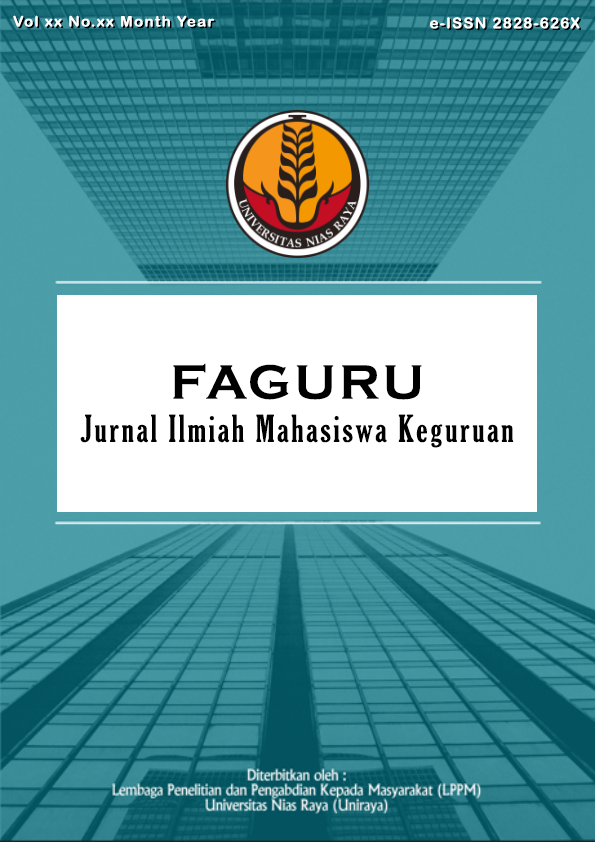HUBUNGAN MINAT BELAJAR SISWA TERHADAP HASIL BELAJAR BIOLOGI PADA SISWA KELAS XI SMA NEGERI 1 TELUKDALAM
Abstract
This study aims to determine the relationship between students' learning interest and their academic achievement in Biology among Grade XI MIPA students at SMA Negeri 1 Telukdalam in the 2024/2025 academic year. The research employs a quantitative approach with a correlational method. The population consists of 108 students. Sampling was conducted using probability sampling with a simple random sampling technique, resulting in 52 students selected as the research sample. Data collection was carried out through questionnaires to measure students' learning interest and documentation of Biology learning outcomes. Data were analyzed using correlation statistics and t-test. Based on the statistical analysis, the calculated t-value was 4.9796, while the t-table value at a 5% significance level with 50 degrees of freedom was 1.67591. Since the t-calculated value is greater than the t-table value, it can be concluded that there is a significant relationship between students' learning interest and their Biology learning outcomes. In other words, the higher the students’ interest in learning, the better their academic performance in Biology tends to be. Suggestion: Schools and teachers are encouraged to enhance students’ learning motivation and implement effective teaching strategies that foster learning interest, such as interactive methods, engaging educational media, and consistent positive reinforcement to help improve student outcomes.
References
Ames, C. (1992). Classrooms: Goals, structures, and student motivation. Journal of Educational Psychology, 84(3), 261–271.
Anderson, L. Gutman & Schoon, I. (2013). The Impact of non cognitive skills on outcomes for young people (Education Endowment Foundation).
Asmawati Munir, M., Sabilu, M., & Lestari, W. (2023). Hubungan Minat Belajar dengan Hasil Belajar Biologi Siswa Kelas XI IPA SMA Negeri 10 Kendari. AMPIBI: Jurnal Alumni Pendidikan Biologi, 8(1), 61–67. https://doi.org/10.36709/ampibi.v8i1.13
Bandura, A. (1997). Self-efficacy: The exercise of control. W.H. Freeman.
Binuni, J., Kaunang, E. S. N., & Sumampouw, H. M. (2017). Hubungan Minat terhadap Hasil Belajar Siswa pada Mata Pelajaran IPA Biologi SMA Negeri 2 Tondano. JSME (Jurnal Sains Matematika dan Edukasi).
Bukola, O. (2022). Science Experience as Correlate of Student Learning Outcome. International Journal of Theory and Application in Elementary and Secondary School Education, 3(1). https://doi.org/10.31098/ijtaese.v3i1.274
Creswell, J. W. (2013). Research Design: Qualitative, Quantitative, and Mixed Methods Approaches. Sage.
Dahliani, E. R., Rahmatan, H., & Djufri. (2020). The correlation between students’ interest and learning outcomes in biology. J. Phys.: Conf. Ser. 1460:012072. https://doi.org/10.1088/1742 6596/1460/1/012072
Dweck, C. S., & Leggett, E. L. (1988). A social-cognitive approach to motivation and personality. Psychological Review, 95(2), 256–273.
Eccles, J. S. & Wigfield, A. (2002). Motivational beliefs, values, and goals. Annual Review of Psychology, 53, 109–132. https://doi.org/10.1146/annurev.psych.53.100901.135153
Eccles, J. S., Wigfield, A., & colleagues (2015). Experience and value theories of motivation in STEM learning.
Febrianti, R. R., & Ferazona, S. (2024). Analisis Hubungan Minat Belajar terhadap Hasil Belajar Biologi Siswa di SMA Negeri 11 Pekanbaru Tahun Ajaran 2023/2024. Jurnal Citra Pendidikan, 4(2), 1746–1754. https://doi.org/10.38048/jcp.v4i2.3461
Fraenkel, J. R., Wallen, N. E., & Hyun, H. H. (2012). How to Design and Evaluate Research in Education. McGraw Hill.
Gustia, L., & Suhartini, S. (2021). Students’ interest and cognitive learning outcomes: Biology education in high schools during COVID 19. Biosfer: Jurnal Pendidikan Biologi, 14(1), 75–85. https://doi.org/10.21009/biosferjpb.18663
Harefa, D. (2025). Improving Environmental Conservation Skills through Science Learning that Values the Local Wisdom of Hombo Batu in the Botohilitano Indigenous Community. Global Sustainability and Community Engagement, 1(3), 119–130. Retrieved from https://iesrjournal.com/index.php/gsce/article/view/302
Harefa, D. (2025). Fisika Di Dunia Nyata : Evaluasi Pendidikan IPA Yang Tak Sekadar Hitungan Dan Rumus. CV Lutfi Gilang
Harefa, D. (2025). Getting To Know Yahowu And Ya’ahowu Warm Greetings From The Nias Community. KOHESI : Jurnal Pendidikan Bahasa Dan Sastra Indonesia, 5(2), 15-27. Https://Doi.Org/10.57094/Kohesi.V5i2.2559
Harefa, D. (2025). Filsafat Pendidikan Nasional Sebagai Budaya Kearifan Lokal Nias. CV Lutfi Gilang
Harefa, D. (2025). Globalizing Hombo Batu The Role Of English In Promoting Nias Local Wisdom On The International Stage. Research On English Language Education, 7(1), 74-91. Https://Doi.Org/10.57094/Relation.V7i1.2638
Harefa, D. (2025). Hombo Batu A Traditional Art That Can Be Explained With The Laws Of Physics. FAGURU: Jurnal Ilmiah Mahasiswa Keguruan, 4(1), 264-276. Https://Doi.Org/10.57094/Faguru.V4i1.2459
Harefa, D. (2025). Hombo Batu The Tradition Of South Nias That Teaches Courage And Cooperation. FAGURU: Jurnal Ilmiah Mahasiswa Keguruan, 4(1), 75-84. Https://Doi.Org/10.57094/Faguru.V4i1.2454
Harefa, D. (2025). Implementation Of Pancasila Character Education In Hombo Batu In South Nias. CIVIC SOCIETY RESEARCH And EDUCATION: Jurnal Pendidikan Pancasila Dan Kewarganegaraan. 6(1), 1-13, Https://Doi.Org/10.57094/Jpkn.V6i1.2566
Harefa, D. (2025). Innovation In Social Science Learning Based On Local Wisdom: Hombo Batu As A Cultural Education Media In South Nias. Curve Elasticity: Jurnal Pendidikan Ekonomi, 6(1), 15-27. Https://Doi.Org/10.57094/Jpe.V6i1.2555
Harefa, D. (2025). Integrating Character Education Into Science Learning To Improve Academic Achievement At Sma Teluk Dalam. Tunas : Jurnal Pendidikan Biologi, 6(1), 1-13. Https://Doi.Org/10.57094/Tunas.V6i1.2909
Harefa, D. (2025). Kearifan Lokal Nias Dalam Pembelajaran IPA. CV Jejak (Jejak Publisher)
Harefa, D. (2025). Mathematics As A Philosophical Foundation In Hombo Batu: Exploring Nias’ Local Wisdom Through The Perspective Of Mathematics. Afore : Jurnal Pendidikan Matematika, 4(1), 13-26. Https://Doi.Org/10.57094/Afore.V4i1.2557
Harefa, D. (2025). Ruang Lingkup Ilmu Pengetahuan Alam Sekolah Dasar. CV Jejak (Jejak Publisher)
Harefa, D. (2025). The Application Of Hombo Batu Local Wisdom-Based Learning In Enhancing Student Discipline And Cooperation In The Nias Islands. Ndrumi : Jurnal Ilmu Pendidikan Dan Humaniora, 8(1), 14-27. Https://Doi.Org/10.57094/Ndrumi.V8i1.2565
Harefa, D. (2025). The Influence Of Soil Texture Types On Land Resilience To Drought In South Nias. Jurnal Sapta Agrica, 4(1), 13-30. Https://Doi.Org/10.57094/Jsa.V4i1.2585
Harefa, D. (2025). Transformasi Pendidikan IPA Fisika Di Era Industri 5.0 : Mempersiapkan Generasi Pintar Dan Berinovasi, CV Lutfi Gilang
Harefa, D., I Made Sutajaya, I Wayan Suja, & Ida Bagus Made Astawa. (2024). Lowalangi Dalam Konsep Tri Hita Karana Dalam Kearifan Lokal NIAS. Ndrumi : Jurnal Ilmu Pendidikan Dan Humaniora, 7(2), 51-61. Https://Doi.Org/10.57094/Ndrumi.V7i2.2226
Harefa, D., I Made Sutajaya, I Wayan Suja, & Ida Bagus Made Astawa. (2024). Nilai Moral Tri Hita Karana Dalam Album “Keramat” Ciptaan H. Rhoma Irama. Ndrumi : Jurnal Ilmu Pendidikan Dan Humaniora, 7(2), 1-15. Https://Doi.Org/10.57094/Ndrumi.V7i2.2117
Hazari, Z., Potvin, G., Cribbs, J. D., et al. (2017). Interest in STEM is contagious for students in biology, chemistry, and physics classes. Science Advances, 3(8):e1700046. https://doi.org/10.1126/sciadv.1700046
Hidi, S. & Renninger, K. A. (2006). The four-phase model of interest development. Educational Psychologist, 41(2), 111–127. https://doi.org/10.1207/s15326985ep4102_4
Hossan, D., Mansor, Z. D., & Jaharuddin, N. S. (2023). Research Population and Sampling in Quantitative Study. International Journal of Business and Technopreneurship, 13(3), 209–222. https://doi.org/10.58915/ijbt.v13i3.263
Hulleman, C. S. & Harackiewicz, J. M. (2009). Promoting interest and performance in high school science classes. Science, 326(5958), 1410–1412. https://doi.org/10.1126/science.1177067
Isaak, R. C., Kleinert, S. I., & Wilde, M. (2022). The Influence of Gender and Interest on the Use of Learning Strategies in Biology Lessons. European Journal of Educational Research, 11(1), 587–597. https://doi.org/10.12973/eu jer.11.1.587
Motivation and achievement in college: A hierarchical perspective.
Onu et al. (2020). Improving Biology Students’ Interest and Achievement through Collaborative Instructional Strategy. JESBS, 33(2).
Putri, A. P., Wahyuda, A., Humayroh, S., Rahayu, R. R., & Ramadana, A. P. R. (2023). Pengaruh Minat Siswa pada Pembelajaran Biologi terhadap Hasil Belajar Siswa SMA N 1 Beringin. BIODIK, 9(1), 123-127. https://doi.org/10.22437/bio.v9i1.19679
Rahmi, N. A., Sumarmin, R., Ahda, Y., Alberida, H., & Razak, A. (2021). Relationship between Learning Motivation and Biology Learning Outcomes. Jurnal Penelitian Pendidikan IPA, 7(4), 537–541. https://doi.org/10.29303/jppipa.v7i4.773
Renninger, K. A. & Hidi, S. (2016). The Power of Interest for Motivation and Engagement. Routledge.
Rotgans, J. I., & Schmidt, H. G. (2011). The role of teachers in facilitating situational interest in an active learning classroom. Teaching and Teacher Education.
Rowland, A. A., Knekta, E., Eddy, S., & Corwin, L. A. (2019). Defining and Measuring Students’ Interest in Biology: An Analysis of the Biology Education Literature. CBE—Life Sciences Education, 18(3): ar34. https://doi.org/10.1187/cbe.19-02-0037
Siddhart (2011). Correlational Research Design in Educational Studies. Journal of Educational Research Methods.
Simple Random Sampling (SRS). In Thomas et al. (2018), sampling techniques overview. International Journal of Education & Language Studies. https://doi.org/10.XXXX/ijels.vX.iX.XXX
Sundariati et al. (2023). Peran kecerdasan emosional dan minat belajar terhadap prestasi Biologi siswa kelas XI. Jurnal Pendidikan Biologi Lokal.
Survey Methodology. Groves, Fowler, Couper, Lepkowski & Singer (2009). Survey Methodology. John Wiley & Sons.
Telaumbanu, T., Murnihati Sarumaha, Kaminudin Telaumbanua, Baziduhu Laia, Fatolosa Hulu, Harefa, D., & Anita Zagoto. (2025). Transformasi Botol Plastik Aqua Menjadi Tempat Sampah Ramah Lingkungan Berbasis Kearifan Lokal Desa Bawolowalangi. Haga : Jurnal Pengabdian Kepada Masyarakat, 4(1), 1-14. Https://Doi.Org/10.57094/Haga.V4i1.2779
Toni Hidayat, Amaano Fau, & Darmawan Harefa. (2023). Pengaruh Model Pembelajaran Index Card Match Terhadap Hasil Belajar Siswa Pada Mata Pelajaran Ipa Terpadu. TUNAS : Jurnal Pendidikan Biologi, 4(1), 61 - 72. Https://Doi.Org/10.57094/Tunas.V4i1.885
Ulandari, S., & Pranata, O. D. (2025). Minat Belajar Siswa pada Konteks Integratif: Analisis Kondisi dan Faktor yang Mempengaruhinya. Diklabio: Jurnal Pendidikan dan Pembelajaran Biologi, 9(1), 63–78. https://doi.org/10.33369/diklabio.9.1.63-78
Von Stumm, S. (2018). The Hungry Mind: Intellectual Curiosity Is the Third Pillar of Academic Performance. Perspectives on Psychological Science.
Wu, J., Qi, S., & Zhong, Y. (2022). Intrinsic motivation, need for cognition, grit, growth mindset and academic achievement in high school students. arXiv Preprint.









